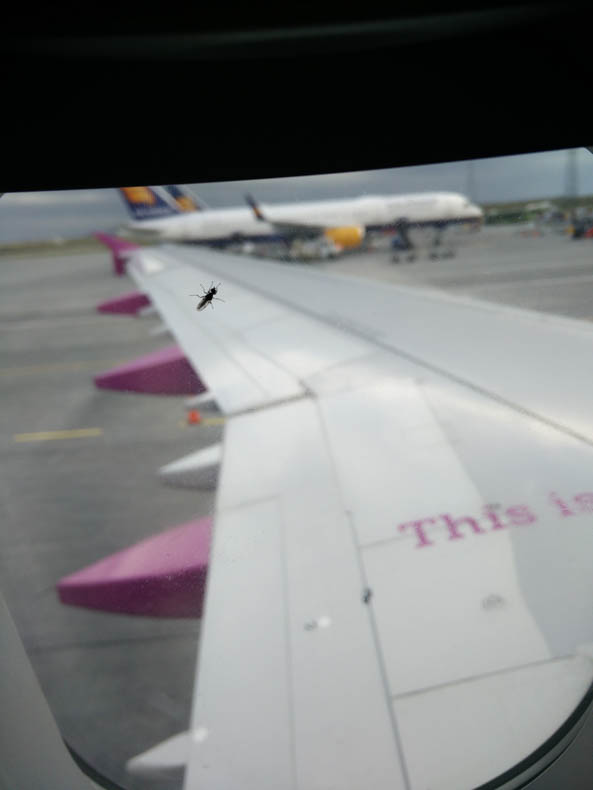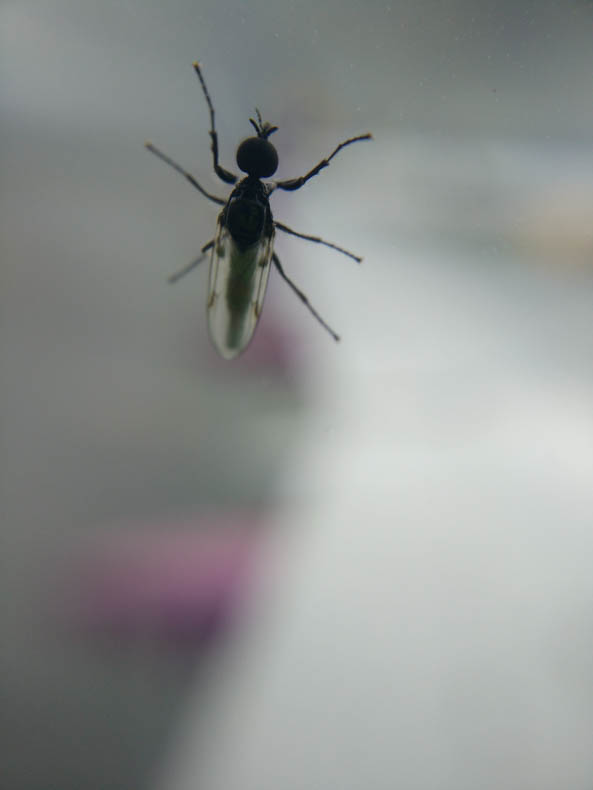
I love seeing bugs on windows, for reasons I’ve never fully worked out. I’ve even written about it before on this blog.
Normally those bugs are on the outside of the window and I’m on the inside. That’s how I prefer it. I think the bugs prefer it that way, too. They are out in the world, taking a pause from their busy lives of flight on a nice smooth piece of glass; I am inside, unable to swat them. I generally don’t swat bugs. I have a soft spot for bugs. (Notable exception.)
This June that usual relationship changed, though. I was inside an airplane, and so was a bug.
The airplane was in Reykjavik, Iceland, waiting for some passengers to arrive from a connecting flight. I was on my way home from Berlin, ready to spend the next several hours alternating between knitting and reading. The weather was lovely in Reykjavik, which I knew because I’d just been outside in it. The plane was parked away from the airport. My fellow passengers and I had taken a shuttle bus out, walked across the tarmac, and marveled at the clouds for a while before climbing up the stairs near the plane’s tail.
I settled into my seat. Then this bug appeared on my window.
I photographed it, of course. And I thought about killing it.
Transporting live animals between far-off locations is generally considered to be a bad thing. Zebra mussels, for example. They’re a nasty invasive species that made their way to the Great Lakes in the ballast water of ships, then spread into many other waterways of the Eastern United States. They grow so densely that they can clog water intake pipes at power plants. Ships now have to exchange their ballast water at sea to reduce the risk of causing problems like that again.
So I looked at that bug, knowing I should kill it.

But once you’ve been staring at a bug for a while, it gets harder to kill.
How did I even know it was an Icelandic bug? I asked myself. Maybe it had gotten on the plane before it last left the U.S.
I lectured myself. There are basically infinite bugs in the world. Killing a bug is not like killing a mammal. It’s ok. The people who study bugs say it’s ok. It’s really ok. I know it’s ok.
Ok, I thought. I’ll do it later.
I watched the bug as the plane took off. I was curious if the forces that push me back into my seat are also relevant if you’re only half an inch long. The answer: yes, it appears so. As the plane sped up, the bug crouched down, gripping the plastic with all six feet–gripping so hard that the feet pulled slowly inward, until it was about to lose its hold and it quickly turned to spread out and try again. After doing that a few times, it got itself oriented so its head was pointing toward the front of the plane and rode out the rest of the takeoff like that. I closed my eyes–being pushed back into the airplane seat makes me sleepy.
The next time I looked, the bug was gone.
Maybe someone else killed the bug. Maybe it was on its last legs already and died before we got to Baltimore. Maybe it’s a male and couldn’t have single-handedly started a new Maryland population of invasive Icelandic insects.
Maybe I’m just trying to excuse myself for being too soft-hearted to kill one stupid bug.
Photos: Helen Fields
I usually don’t kill bugs on the inside of my windows. I just put a drinking glass over them, then slide a piece of paper under it slowly, then take the glass with the bug outdoor and set it free. I hate to watch the poor stupid things torture themselves to death trying to reach the light through the glass, eventually expiring in the process.
A friend of mine studies fruit flies, and one day, out of her many jars of flies, she found a single fly with a beautiful mutation: one perfectly formed wing, the other completely missing. She wanted to breed and study this fly, and put the lucky lad in a vial with lots of female flies. But because he only had one wing, he couldn’t preform the courtship song and dance that all fruit flies use to breed. He tried and tried, but the females didn’t respond. Over and over again, he was rejected. Eventually, to my friends shock and dismay, he simply stopped trying. She kept him for the rest of his life in a little vial on her desk. He never found a mate.
Later, our university hired a new professor who studies alcohol addiction in flies. That’s when I learned that male flies that have been rejected repeatedly grow ‘discouraged’, and will seek out and consume alcohol. The working hypothesis is that these rejected flies are self medicating.
I’ve never been able to kill a fly since.
http://www.nytimes.com/2012/03/16/health/male-fruit-flies-spurned-by-females-turn-to-alcohol.html?_r=0